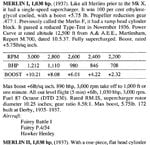I've had the similar thread years before, but perhaps the new people here might give their perspective on topic. Topic being: looking at 1-engined fighters in squadron service, what airframe(s) stand out? So we'd more or less forget the advantage given by engine installed, and look at what tasks the respective airframes were good at:
Payload capability (guns/ammo/fuel), ease of production & maintenace (if that can be quantified/measured), ability to endure harsh field conditions (high or low temperatures, rough/muddy/dusty airstrips etc), pilot's comfort and visibility, ability to easily receive protection updates, all while being structuraly sound and not very difficult for new pilots to understand and use. Not being 'married' to just a single engine type is also a plus. Ability to dive and roll well. Drag & weight - as much as it is related to airframes here - are very important considerations.
Only land-based fighters for this thread, limited to fighters that people were actually using back in 1941. If you think more than one design needs to be on top of the list, feel free to list 2 preferred types instead of just 1.
Payload capability (guns/ammo/fuel), ease of production & maintenace (if that can be quantified/measured), ability to endure harsh field conditions (high or low temperatures, rough/muddy/dusty airstrips etc), pilot's comfort and visibility, ability to easily receive protection updates, all while being structuraly sound and not very difficult for new pilots to understand and use. Not being 'married' to just a single engine type is also a plus. Ability to dive and roll well. Drag & weight - as much as it is related to airframes here - are very important considerations.
Only land-based fighters for this thread, limited to fighters that people were actually using back in 1941. If you think more than one design needs to be on top of the list, feel free to list 2 preferred types instead of just 1.

